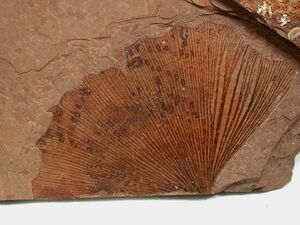جنكة
| جنكة | |
|---|---|

| |
| Ginkgo biloba Eocene, McAbee, B.C., Canada | |
| التصنيف العلمي | |
| أصنوفة غير معروفة (أصلحها): | Ginkgo |
| Type species | |
| Ginkgo biloba | |
| Species | |
| Synonyms [2] | |
|
Salisburia Sm. | |
جنكة أو گنكو Ginkgo هي جنس من النباتات البذرية غير المزهرة والغير معتادة. The scientific name is also used as the English name. The order to which it belongs, Ginkgoales, first appeared in the Permian,[3] 270 million years ago, and is now the only living genus within the order. The rate of evolution within the genus has been slow, and almost all its species had become extinct by the end of the Pliocene; the exception is the sole living species, Ginkgo biloba, which is only found in the wild in China, but is cultivated across the world. The relationships between ginkgos and other groups of plants are not fully resolved.
قبل التاريخ
The ginkgo (Ginkgo biloba) is a living fossil, with fossils similar to the modern plant dating back to the Permian, 270 million years ago. The closest living relatives of the clade are the cycads,[4] which share with the extant G. biloba the characteristic of motile sperm. Fossils attributable to the genus Ginkgo first appeared in the Early Jurassic, and the genus diversified and spread throughout Laurasia during the middle Jurassic and Early Cretaceous. It declined in diversity as the Cretaceous progressed with the extinction of species such as Ginkgo huolinhensis, and by the Palaeocene, only a few Ginkgo species, Ginkgo cranei and Ginkgo adiantoides, remained in the Northern Hemisphere, while a markedly different (and poorly documented) form persisted in the Southern Hemisphere.[بحاجة لمصدر] At the end of the Pliocene, Ginkgo fossils disappeared from the fossil record everywhere except in a small area of central China, where the modern species survived. It is doubtful whether the Northern Hemisphere fossil species of Ginkgo can be reliably distinguished. Given the slow pace of evolution and morphological similarity between members of the genus, there may have been only one or two species existing in the Northern Hemisphere through the entirety of the Cenozoic: present-day G. biloba (including G. adiantoides) and G. gardneri from the Palaeocene of Scotland.[5]

شجرة المحتد
اعتبارا من فبراير 2013[تحديث], molecular phylogenetic studies have produced at least six different placements of Ginkgo relative to cycads, conifers, gnetophytes and angiosperms. The two most common are that Ginkgo is a sister to a clade composed of conifers and gnetophytes and that Ginkgo and cycads form a clade within the gymnosperms. A 2013 study examined the reasons for the discrepant results and concluded that the best support was for the monophyly of Ginkgo and cycads.[6]
المراجع
الهامش
- ^ R. Govaerts. "Ginkgo L., Mant. Pl. 2: 313 (1771)". World Checklist of Selected Plant Families. Royal Botanic Gardens, Kew. Retrieved June 8, 2013.
- ^ "Genus: Ginkgo L." Germplasm Resources Information Network. United States Department of Agriculture. Archived from the original on December 20, 2008. Retrieved June 8, 2013.
- ^ Royer et al. (2003)
- ^ Royer et al. (2003), p. 84.
- ^ Royer et al. (2003), p. 85.
- ^ Wu et al. (2013)
المصادر
- Dana L. Royer, Leo J. Hickey & Scott L. Wing (2003). "Ecological conservatism in the 'living fossil' Ginkgo". Paleobiology. 29 (1): 84–104. doi:10.1666/0094-8373(2003)029<0084:ECITLF>2.0.CO;2.
- Thomas N. Taylor & Edith L. Taylor (1993). The Biology and Evolution of Fossil Plants. Englewood Cliffs, NJ: Prentice Hall. ISBN 0-13-651589-4.
- Chung-Shien Wu, Shu-Miaw Chaw & Ya-Yi Huang (2013). "Chloroplast phylogenomics indicates that Ginkgo biloba is sister to cycads". Genome Biology and Evolution. 5 (1): 243–254. doi:10.1093/gbe/evt001. PMC 3595029. PMID 23315384.